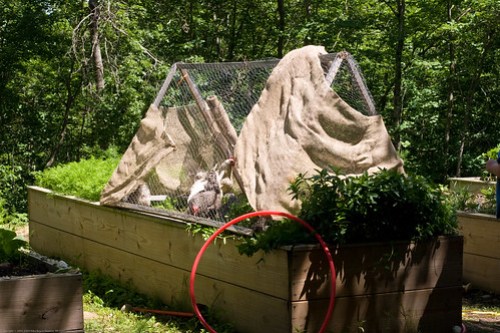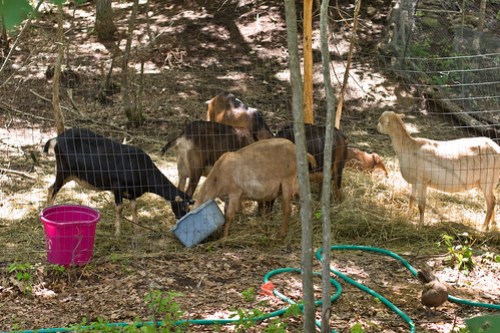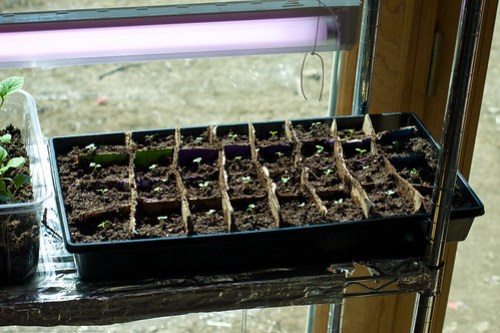
(I have been debating with myself about which blog to post this at, this garden/homestead blog or my peak oil blog, Peaknix. I decided to cross post it to catch both audiences)
Over at Kathy Harrison’s wonderful The Just In Case Book Blog, (Kathy wrote “The Just In Case” book on the practical aspects of preparedness in the home) a post today “How much is too much?” has some great comments (all of her posts do).
One of the commenters wonders about how to chose the “right” meat to store. Should one focus on low cost “low quality” meats grown in CAFOs (Concentrated Animal Feeding Operations) so as to maximize the ability to buy a lot of meat on a limited budget or buy and store organic pastured meats. Its an important question and one that will impact your health. One can ask the same about any part of their food storage.
Meat, thinking about it makes me wax philosophical, angry, perplexed, confused, hungry.
It will require several hands too.
On the one hand meat is what we in the US are raised to eat, lots of it too. Its the main attraction. It means satiety. It defines it.
Without meat, your snacking, your nibbling, your waiting for supper.
For lots of us, that goes a step further and its a meat/starch combo that really signifies a filling meal. I was raised on rice and meat (rice being hugely important to Colombian cuisine, pork being THE meat).
On the other hand, in terms of climate change, meat is a curse to our ecosystems in MANY ways and it endangers the futures of our children.

On the other hand, thanks to swine flu, pork has NEVER been cheaper and when you are on the financial edge, that is deeply welcomed.
On the other hand, the low prices are killing the US pork industry.
On the other hand, we are talking CAFOs here, and they really are the infectious disease problem in terms of being GINORMOUS viral bioreactors.
Its at least 2 fold:
- massive use of antibiotics and growth hormones to make it possible to grow pork flesh in the CAFO setting – that inevitably leads to the breeding of antibiotic resistant strains and meat doped with hormones that ruin our metabolism
- then there is the issue that porcine genetics and anatomy are such that their lungs represent a unique environment where flu viral particles from MANY species can be harbored (and without significant lethality for the pig), side by side, leading to what is called reassortment. The viral genes are swapped back and forth such that new strains arise that can be pandemic in nature, case in point – this is EXACTLY how H1N1 Swine Flu arose in the Smithfield CAFOs in Mexico.
By not supporting this industry through buying their meat products, you the consumer vote against the many dangers that this sort of capitalism generates. Its very simple.
I know that people’s livelihoods depend on CAFOs. Things change and change can be painful. Take for example, my grandfather who used to farm and raise pigs for market in Illinois. He left farming in the 1950s or 60s exactly because of these CAFOs. I have a certain perspective, if you will. After leaving the farm, he never again found a job and sank into alcoholism and died at 61 from congestive heart failure and untreated diabetes.
On the other hand, even just FINDING pastured healthy meats can be quite difficult. It will also be more expensive.
Being raised in a natural setting their immune systems will be INTACT and thus will not require 24/7 vets to pump them full of antibiotics.
More importantly to this discussion – living this way means that the pigs do NOT ingest GMO and species inappropriate feeds that leads to meat and fats literally poisoned with the transfats you thought you were avoiding.
You can eat the fat of pastured animals (beef, pig, lamb, chicken) and receive health benefits. You will not when eating CAFO meats, the reverse is true, you will be eating toxic fats.
Thats just the basic truth of the matter.

(This little guy is a CSA tamworth pig, sold by the Many Hands Organic farm in Barre, MA. See more photos about Many Hands at this flickr set link.)
Now, after all that, I have really run out of hands.
I have a certain bias after thinking on all of this for a while. I do not ascribe to simply storing away a few months or years worth of store bought dried foods. I have never had the money to do that and I dont think I could feed my kids that either.
My sort of preparing is building self-sufficiency so that these skills are passed on to my kids (as this blog has covered at length!) and part of that has been about growing and raising protein.
As The Smiths and the runner duck on “Babe” say, Meat is Murder. Meat requires the death of an animal. Until you have killed your own chickens or pigs for you to eat, you simply do not understand meat.
Now, I am not saying to not eat meat.
I am saying that long term self sufficiency requires serious thought about meat. The health issues mentioned above will ebb away as one raises and butchers their meat. This will be a Good Thing.
The need for meat to be the starring attraction on the dinner plate will likely also change to a more vegetable diet that is accented by proteins that meet the needs of the body not just the corpulent mindset.
I know from personal experience that if I have to go out and kill a chicken to have meat my worldview shifts. My mind runs a calculation – does my body really need the meat or can more vegetable do the trick. If I had no children I would likely be 100% ovo-lacto vegetarian because my calculation really is weighted more to the NO side in terms of an answer.
But when I think about the bodies of my kids, meat gets a big thumbs up! I know that is absolutely my own bias and that many people raise their kids as vegetarians. To each his own, especially in this aspect.
None of us asked to be born in such complex, conflicting, and confounding times. Its not our fault that our world is filled with about 5 billion too many people (WELL over its carrying capacity). Its also not our fault that a guy at the beginning of the previous century figured out a way to use the technology created to make chemical bombs in the first world war and apply it to the making of artificial fertilizer – leading to the profound shift in our food production systems and a mortal link to non-renewable fossil fuels that has a significant impact on the global climate.
It is said that without that innovation, making artificial fertilizer from fossil fuels, 3/5ths of the people alive today would not have been born.
These are all facts of our modern world. How we weather the changes or how we prepare our children to weather the changes will be important, even if its a small choice between CAFO meat or organic pastured meat (supporting small farms who value their land) or if it means eating less or no meat at all.







































































































